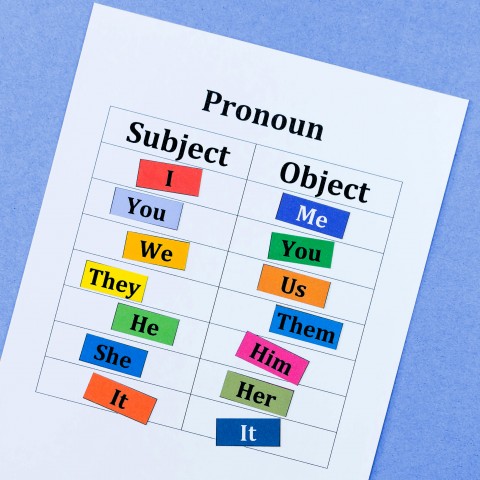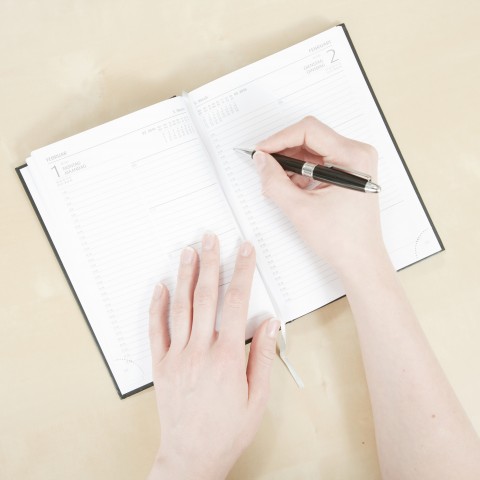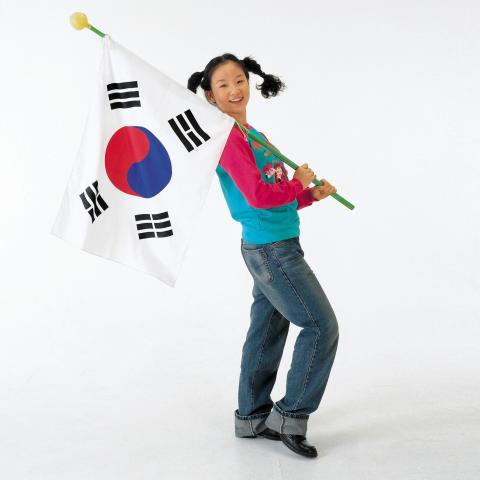
How to compose proper sentence structures is one of the most important language skills you can learn, because you can’t speak or write properly without knowing how to put sentences together. In this article, we’ll teach you basic Korean sentence structure and word order so that you can write a Korean sentence or speak with local friends.
 Table of Contents
Table of Contents
- Overview of Word Order in Korean
- Basic Word Order with Subject, Verb, and Object
- Word Order with Prepositional Phrases
- Word Order with Modifiers
- How to Change the Sentence into a Yes-or-No Question
- Korean Word Order Practice
- How KoreanClass101 Can Help You with Your Korean Skills
1. Overview of Word Order in Korean

The Korean language word order is SOV. Therefore, the default grammatical order is always subject – object – verb.
Example:
- 호랑이가 먹이를 먹어요.
Horangiga meogireul meogeoyo.
“A tiger is eating prey.“
The Korean sentence structure and word order are different from those in English, which has an SVO (subject – verb –object) word order. The easiest way to remember the difference is that only the verb and object positions are switched.
Let’s take a look at another example from Wikipedia.
- 내가 상자를 연다.
Naega sangjareul yeonda.
“I open the box.“
Congratulations! You’ve just mastered the first basic Korean sentence structure pattern, and you’re ready to learn how to construct Korean sentences. Let’s go!

2. Basic Word Order with Subject, Verb, and Object
Rule #1: Subject + Noun pattern
The first rule of Korean word order is the subject + noun pattern. Here are two tables of Korean subjects and grammar structures to help you construct Korean sentences. Once you familiarize yourself with them, you’ll be able to form Korean sentences easily.
A. Basic Vocabulary for Korean Subjects
| Subject | Romanization | English | Politeness |
|---|---|---|---|
| 나는 | naneun | “I am” | informal |
| 저는 | jeoneun | “I am” | formal |
| 너는 | neoneun | “You are” | informal |
| 당신은 | dangsineun | “You are” | formal |
| 그는 | geuneun | “He is” | formal |
| 그녀는 | geunyeoneun | “She is” | formal |
| *”He is” and “she is” are rarely used in spoken language. Try replacing the subject with a person’s name, such as 하영이는 (hayeongineun), 민경씨는 (mingyeongssineun), 영우님은 (yeongunimeun), etc. | |||
| 우리는 | urineun | “We are” | informal |
| 그들은 | geudeureun | “They are” | formal |
| “We are” in the formal register is rarely used in spoken language. When speaking, try saying 우리들은 (urideureun) instead. | |||
B. Basic Grammar Structure to Remember
| Subject | Romanization | English | Politeness |
|---|---|---|---|
| ~ 이다. | ~ ida. | “~am” | informal |
| ~ 입니다. | ~ imnida. | “~am” | formal |
| (이)에요. | (i)eyo. | “~is” | formal |
When constructing the phrases above, you will always need to add a noun before. Let’s have a look at an example.
Example:
- 나는 학생이다. (informal/writing)
Naneun haksaengida.
“I am a student.“
- 저는 학생이에요. (formal/speaking)
Jeoneun haksaengieyo.
“I am a student.“
Rule #2: Subject + Object + Verb pattern
The second rule of word order in Korean is the subject – object – verb rule we discussed at the beginning of this article. This is the default rule for how to complete a sentence.
Example:
- 저는 사과를 먹어요.
Jeoneun sagwareul meogeoyo.
“I eat an apple.”
Rule #3: Subject + Verb pattern
The third rule of Korean word order is the subject + verb sentence pattern. This is the easiest Korean sentence structure, and the pattern is similar to English. This SV pattern is usually used when you want to give a simple and direct answer to a question, without giving much context. For example, when someone asks “What is she doing?” you can simply answer by saying “She’s sleeping.”
Example:
- A: 지금 앤은 뭐해?
A: Jigeum aeneun mwohae?
A: “What is Anne up to?”
- B: 앤은 지금 요리해.
B: Aeneun jigeum yorihae.
B: “Anne is cooking now.”
Rule #4: Subject + Adjective pattern
The fourth rule of Korean word order is the subject + adjective sentence pattern, which is very similar to English. As we know, adjectives describe nouns or pronouns.
Example:
- 앤은 예뻐.
Aeneun yeppeo.
“Anne is pretty.“
- 수업은 지루해요.
Sueobeun jiruhaeyo.
“The class is boring.”

3. Word Order with Prepositional Phrases
Now, let’s see how prepositional phrases come into Korean word order. According to Grammarly, a prepositional phrase is a group of words that contain a preposition, its object, and modifiers for that object. Let’s have a look at the ten most commonly used Korean prepositional phrases.
1. ~ 의 앞에 (ui ap-e), “in front of”
Rules:
1) Add only the object in front of the prepositional phrase.
2) You can remove 의 when speaking. (e.g. 슈퍼마켓 앞에)
A. Simple SOV Sentence:
subject – object – verb
- 강아지는 슈퍼마켓에 있어요.
Gangajineun syupeomakese isseoyo.
“The dog is at the supermarket.“
B. Prepositional Phrase Example:
- 강아지는 슈퍼마켓의 앞에 있어요.
Gangajineun syupeomakesui ape isseoyo.
“The dog is in front of the supermarket.”
2. ~ 의 뒤에 (dwie), “behind”
Rules:
1) Add only the object in front of the prepositional phrase.
2) You can remove 의 when speaking. (e.g. 소파 뒤에)
A. Simple SOV Sentence:
subject – object – verb
- 강아지는 소파에 앉아있어요.
Gangajineun sopae anjaisseoyo.
“The dog is sitting on the sofa.”
B. Prepositional Phrase Example:
- 강아지는 소파의 뒤에 앉아있어요.
Gangajineun sopaui dwie anjaisseoyo.
“The dog is sitting behind the sofa.“
3. ~ 의 안에 (~ui ane), “inside”
Rules:
1) Add only the object in front of the prepositional phrase.
2) You can remove 의 when speaking. (e.g. 슈퍼마켓 뒤에)
A. Simple SOV Sentence:
subject – object – verb
- 강아지는 슈퍼마켓에 앉아있어요.
Gangajineun syupeomakese anjaisseoyo.
“The dog is sitting by the sofa.“
B. Prepositional Phrase Example:
- 강아지는 슈퍼마켓의 안에 앉아있어요.
Gangajineun syupeomakesui ane anjaisseoyo.
“The dog is sitting inside the supermarket.“
4. ~의 위에 (wie), “on”
Rules:
1) Add only the object in front of the prepositional phrase.
2) You can remove 의 when speaking. (e.g. 책상 위에)
A. Simple SOV Sentence:
subject – object – verb
- 바나나는 책상에 있어요.
Banananeun chaeksange isseoyo.
“The banana is at the table.”
B. Prepositional Phrase Example:
- 바나나는 책상의 위에 있어요.
Banananeun chaeksangui wie isseoyo.
“The banana is on the table.”
5. ~ 밑에 (mite), “under”
Rules:
1) Add only the object in front of the prepositional phrase.
2) You can remove 의 when speaking. (e.g. 책상 밑에)
A. Simple SOV Sentence:
subject – object – verb
- 바나나는 책상에 있어요.
Banananeun chaeksange isseoyo.
“The banana is at the table.”
B. Prepositional Phrase Example:
- 바나나는 책상의 밑에 있어요.
Banananeun chaeksangui wie isseoyo.
“The banana is under the table.”
6. ~ 과/와 함께 (gwa hamkke), “together with”
Rules:
1) Add only the object in front of the prepositional phrase.
2) In spoken language, you can say 주인이랑 (juinirang) instead of 주인과 (juingwa); there’s no change in the meaning.
A. Simple SOV Sentence:
subject – object – verb
- 강아지는 주인과 산책해요.
Gangajineun juingwa sanchaekaeyo.
“The dog walks with the owner.”
B. Prepositional Phrase Example:
- 강아지는 주인과 함께 산책해요.
Gangajineun juingwa hamkke sanchaekaeyo.
“The dog walks together with the owner.”
7. ~에 관한 (~e gwanhan), “about”
Rule:
1) Add only the noun in front of the prepositional phrase.
A. Simple SV Sentence:
subject – verb
- 애나는 발표해요.
Aenaneun balpyohaeyo.
“Anna presents.”
B. Prepositional Phrase Example:
- 애나는 한국문화에 관한 주제로 발표해요.
Aenaneun hangungmunhwae gwanhan jujero balpyohaeyo.
“Anna presents about Korean culture.“
8. ~때문에 (~ttae mune), “Because of~”
A. Simple SV Sentence:
subject – verb
- 운동회가 취소되었다.
Undonghoega chwisodoeeotda.
“Sport Day is canceled.“
B. Prepositional Phrase Example:
- 운동회가 비 때문에 취소되었다.
Undonghoega bi ttaemune chwisodoeeotda.
“Sport Day is canceled because of the rain.“
9. ~한테 (hante), “To someone” / “From someone” / “By someone”
A. Simple SA Sentence:
subject + adjective
- 이 훈련은 어려워요.
I hullyeoneun eoryeowoyo.
“This training is difficult.“
B. Prepositional Phrase Example Using “TO someone”:
- 이 훈련은 강아지한테 어려워요.
I hullyeoneun gangajihante eoryeowoyo.
“This training is difficult to (for) the dog.”
C. Simple SOV Sentence:
subject – object – verb
- 저는 장난감을 받았어요.
Jeoneun jangnangameul badasseoyo.
“I received a toy.“
D. Prepositional Phrase Example Using “FROM someone”:
- 저는 장난감을 친구한테 받았어요.
Jeoneun i jangnangameun chinguhante badasseoyo.
“I got this toy from my friend.”
E. Simple SV Sentence:
subject – verb
- 강아지가 물어요.
Gangajiga mureosseoyo.
“A dog bites.“
F. Prepositional Phrase Example Using “BY someone”:
- 저는 강아지한테 물렸어요.
Jeoneun gangajihante mullyeosseoyo.
“I got bitten by a dog.“
10. 으로 / 로 (euro / ro), “to” [destination]
Simple SV Sentence:
subject – verb
- 저는 여행할 거예요.
Jeoneun yeohaenghal geoyeyo.
“I’m going to travel.“
A. Prepositional Phrase Example:
- 저는 프랑스로 여행할 거예요.
Jeoneun peurangseuro yeohaenggal geoyeyo.
“I’ll travel to France.“

4. Word Order with Modifiers
Descriptive verbs can become noun modifiers and describe the nouns directly. The verb acts as an adjective to modify a noun, which must follow immediately. In Korean grammar, word order with modifiers has two rules you need to remember. So, let’s take a look.
1. General Rule #1 – V + ~는 것 (geot)
The first rule for modifiers in Korean word order is the V + ~것 (geot) pattern, which is used to nominalize action verbs. It indicates the gerund form of a verb (e.g. X-ing).
Example:
1. 가다 (gada), “to go”
2. 가 (ga) is the verb stem
3. 가 (ga) + -는 것 (neun geot)
4. It becomes 가는 것 (ganeun geot), which means “going,” and the verb became the noun
2. General Rule #2 – n~은 (eun) + noun
Descriptive verbs can become noun modifiers and describe the nouns directly. The verb acts as an adjective to modify a noun, which must follow immediately. We usually translate the descriptive verb as “to be [Adjective].” Let’s have a look at an example.
Example:
1. 작다 (jakda), “to be small”
2. 작 (verb stem ending in a consonant) + -은 (eun) becomes 작은 (jakeun), meaning “small.”
3. 작은 + 모자 (noun) becomes 작은 모자 (jakeunmoja), meaning “a small hat.”
Note that ~은 (eun) is attached to the end of clauses that end in consonants. If there’s no consonant at the end of a clause, the rule is slightly different.
Example:
1. 나쁘다 (nappeuda), “to be bad”
2. 나쁘 (verb stem ending without a consonant) + ~은 (eun) becomes 나쁜 (nappeun), meaning “bad.”
3. 나쁜 + 사람 (noun) becomes 나쁜 사람 (nappeunsaram), meaning “a bad person.”
Check out our lesson on Noun Modifying Particles to learn more about modifiers.

5. How to Change the Sentence into a Yes-or-No Question
Asking questions in Korean doesn’t require a complicated sentence structure. All you need to do is raise the end of the sentence in order to form a question.
“Dad sleeps” in Korean is 아빠는 자요 (Appaneun jayo). If you raise the end of the word 요 (yo), it becomes a yes-or-no question: 아빠는 자요↗ ? (Appaneun jayo?), meaning “Is dad asleep?” Perhaps this is the easiest Korean sentence structure we’ll learn today.
Examples:
- 어제 학교 갔었어요. (Eoje hakgyo gasseosseoyo.) “I went to school yesterday.”
- 어제 학교 갔었어요↗ ? (Eoje hakgyo gasseosseoyo?) “Did you go to school yesterday?”
- 어제 공부했어. (Eoje gongbuhaesseo.) “I studied yesterday.”
- 어제 공부했어↗ ? (Eoje gongbuhaesseo?) “Did you study yesterday?”
- 한국어 할 수 있어요. (Hangugeo hal su isseoyo.) “I can speak Korean.”
- 한국어 할 수 있어요↗ ? (Hangugeo hal su isseoyo?) “Can you speak Korean?”
You need to be able to answer “Yes” or “No” when someone asks you a question. You may already know these, but let’s review them again.
How to Say “Yes” and “No” in Korean
| Korean | Romanization | English | Politeness |
|---|---|---|---|
| 예 | ye | “Yes” | formal |
| 응 | eung | “Yes” | informal |
| 아니요 | aniyo | “No” | formal |
| 아니 | ani | “No” | informal |
Example:
- 프랑스어 해↗?
Peurangseueohae?
“Can you speak French?”
- 아니, 못해. (Ani, mothae.) “No, I can’t.” / 응, 해. (Eung, hae.) “Yes, I can.”

Let’s do some exercises
6. Korean Word Order Practice
Now that we’ve learned some basic Korean sentence structures, let’s do some practice exercises.
Question 1
Translate a simple sentence in Korean. How do you say “I open the box” in Korean? (Hint: Check Part 1)
Question 2
How do you say “The dog is in front of the supermarket” in Korean? (Hint: Check Part 3)
1) 강아지는 슈퍼마켓의 뒤에 있어요.
2) 강아지는 슈퍼마켓의 앞에 있어요.
3) 강아지는 슈퍼마켓의 옆에 있어요.
4) 강아지는 슈퍼마켓과 함께 있어요.
5) 강아지는 슈퍼마켓의 안에 있어요.
Question 3
Write this yes-or-no question in Korean. “Did you go to school yesterday?” (Hint: Check Part 5)

7. How KoreanClass101 Can Help You with Your Korean Skills
In summary, we’ve learned basic Korean sentence structures by going over four basic word order patterns, ten of the most commonly used Korean prepositional phrases, two important modifier rules, and how to form yes-or-no questions.
Once you familiarize yourself with these Korean sentence structures, you’ll be able to write a diary in Korean and continue learning about how to form advanced sentence structures! So keep studying. Here are more pages for you to learn about Korean sentence structure.
From KoreanClass101:
- Korean Grammar
- Korean Verbs
- Basic Korean Grammar
- How to Form Korean Phrases? Sentence Order | Basic Korean Phrases
- Basic Korean Sentence Structure
Other Websites:
We hope you enjoyed learning with KoreanClass101! Feel free to reach out to us in the comments section with any questions or concerns you have about Korean word order, and we’ll be glad to help!










